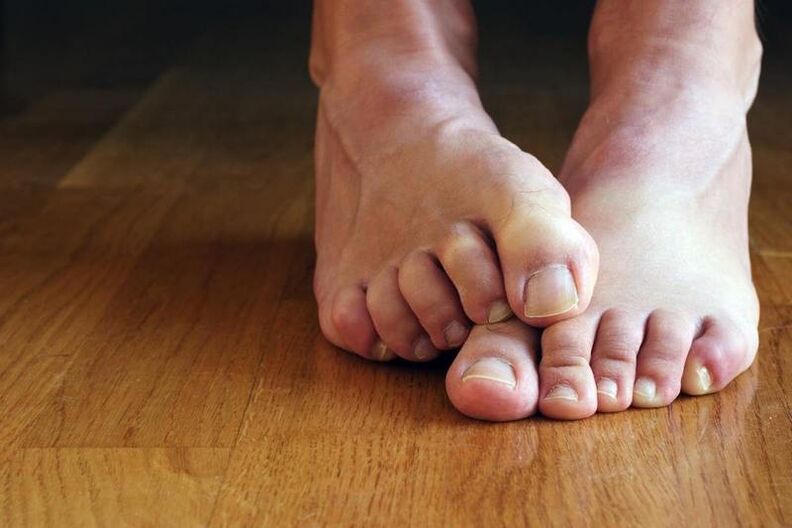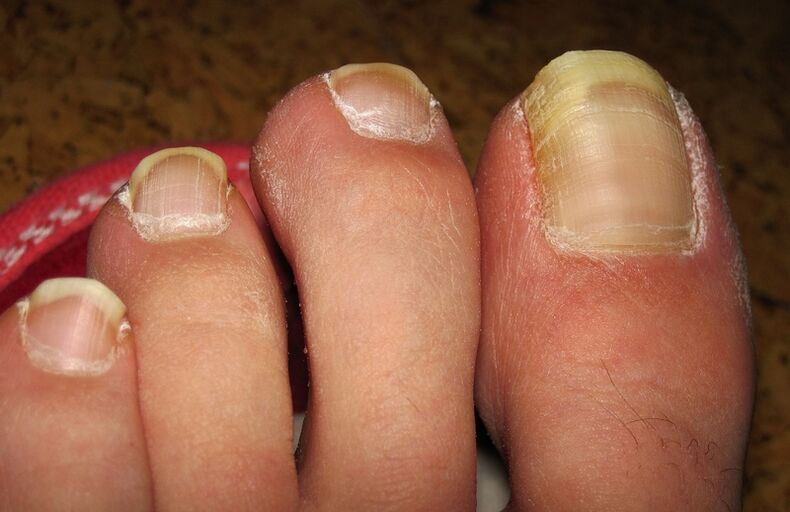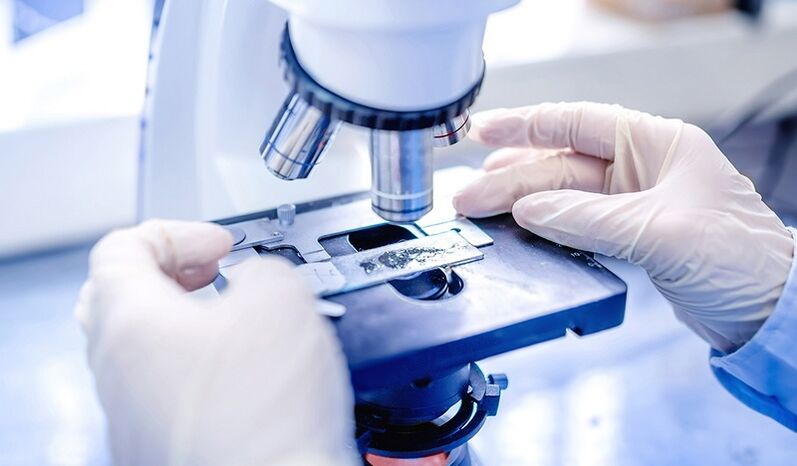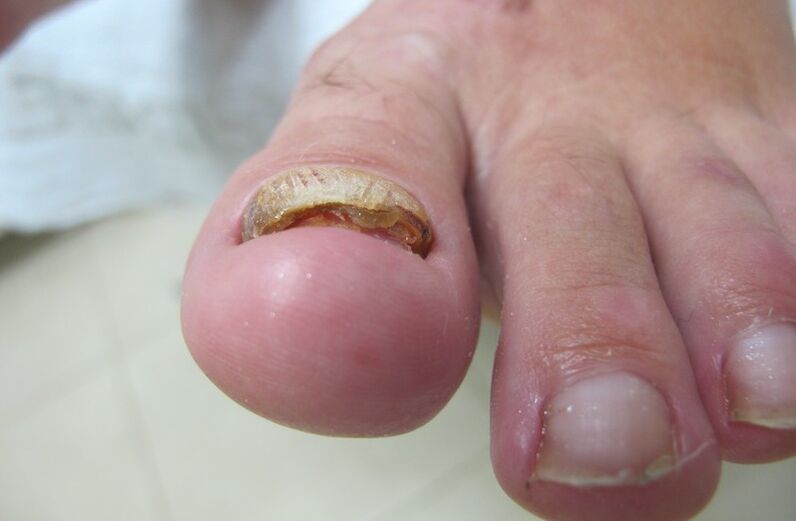Fungal diseases of the toenails are quite common in humans. In addition to the undesirable cosmetic effect, these infections can cause significant harm to the body, so onychomycosis must be treated. But for this you need to know as much as possible about this disease, especially since today scientists have identified a large number of species of pathogens.
Types of pathogens
With onychomycosis, parasites begin in the structure of the nail tissue and in the skin around them. According to the generally accepted classification, spore microorganisms that can appear in humans are divided into three groups:
- nail fungus, mainly Candida albicans;
- dermatophyte fungi (genus Trichophyton, Microsporum and Epidermophyton);
- fungal species (genus Aspergillus, Alternaria and Fusarium).
Acute or chronic onychomycosis causes each of them separately. It is also not uncommon for two or, more rarely, three of these species to become infected at the same time. During diagnosis, it is extremely important to accurately detect the pathogen, because each of the groups of fungal diseases can be treated with different drugs that are not universal.

Reasons for submission
The reasons for the development of the infection can be associated with the entry of the pathogen from the external environment, as well as with the general condition of the patient's body. Their knowledge will help you understand how to treat nail fungus.
External sources of fungal spread include:
- Swimming pools, locker rooms, showers, bathrooms - those public places where a person walks barefoot. Therefore, when visiting such facilities, slippers should be worn for safety.
- Using poorly disinfected tools in beauty salons during a pedicure, which can generally be dangerous to the body.
- Other people's files, scissors and other products used for personal hygiene pose no less of a threat.
- In summer, closed shoes can pose a risk, in which the feet will sweat a lot.
- To not treat onychomycosis of the nails, you should take a bath or shower regularly, as sweat and dirt act as a favorable environment for germs.
- Some types of onychomycosis are transmitted by pets, but such pathogens are common mainly in hot places.
Other health problems also contribute to the development of the disease described:
- Weakened immune system.
- Presence of small wounds and cracks in the skin, dry tissue.
- A large number of scratches.
- Violation of the blood circulation of the nail tissue.
- Contact with fungal pathogens from human skin. This method of infection is called autoinfection.
Thus, there are many sources of infection with fungal diseases. These microorganisms are very common all over the world, so a disease like nail fungus appears in many people. So knowing how to treat onychomycosis will never be superfluous.
Symptoms and diagnosis
The appearance of a fungus on the foot does not mean the inevitable development of the disease. Onychomycosis develops only in a person with a weakened immune system. But there are many possibilities for how nail fungus manifests itself. In this case, pay attention to the following symptoms of nail fungus:
- compression or reduction of the thickness of the corneal layer;
- high brittleness of the nail plate, its distortion;
- the presence of scratches and calluses;
- unnatural color: shades of white, yellow or green;
- roughness of the nail plate surface;
- loss of natural luster;
- inflammation of the skin of the toes, itching in the feet;
- cracked foot.

From these signs, you can find out how nail fungus starts.
Treating advanced nail fungus is extremely difficult and lengthy. This is why the onset of onychomycosis symptoms cannot be ignored. If they are found, you should seek medical help immediately.
The main purpose of diagnosing nail fungus is to accurately determine the causative agent of the infection. Many types of parasitic organisms are extremely difficult to detect, especially since the outward signs of the disease are easily confused with metabolic disorders.
Onychomycosis is usually diagnosed in several stages, for which the following methods are used to identify nail fungus:
- study of clinical data;
- analysis of a piece of tissue under a microscope;
- cultural diagnostics;
- DNA research.
During the examination of the patient at the first appointment, the doctor may diagnose the presence of damage to the nail plate, however, without conducting accurate studies, it is not possible to understand what caused the disease. Laboratory research is the only way to identify nail fungus.
By examining an itch under a microscope, a doctor can tell you exactly what nail fungus looks like. The difficulty lies in determining the specific type of pathogen. Therefore, at this stage, the diagnosis does not stop.
The exact culture of the fungus is determined by its propagation in the laboratory. To do this, an analysis for nail fungus based on a special Sabouraud nutrient medium is used. Usually, after three to five days of such a study, specialists are able to determine the specific type of pathogen. Also, using this method, you can check the susceptibility of parasites to medication and prescribe the most effective course of treatment.

Parasite DNA testing is the current and most promising option for identifying toenail fungus, reducing the time it takes to get results in a day or two. However, such an analysis for nail fungus can only effectively detect yeast species.
Who is at risk
As already mentioned, some categories of people are prone to onychomycosis to varying degrees. The following are the main factors that increase the likelihood of developing an infection:
- Reaching retirement age. Due to reduced blood circulation and deterioration of metabolism, this disease is much more common in the elderly than in other categories of the population. Delayed diagnosis also plays an important role in this, as retirees, having discovered the symptoms of nail fungus and considering it a common sign of aging, do not always seek qualified help.
- Mechanical damage to nail tissue. Any damage impairs the supply of nutrients to the tissues. As a result, a focus of infection will start at the site of a fracture or crack, which then spreads throughout the nail, which can even fly simply out of it.
- High blood sugar levels cause damage to the blood vessels in the legs. Therefore, the manifestation of onychomycosis is so common in diabetics, from which it is also extremely difficult for them to get rid of.
- For exactly the same reason, diseases of the circulatory system, such as Raynaud's syndrome or varicose veins, can cause an infection.
- Because spores are most often able to multiply in both nail tissue and the body surface, people affected by fungal skin infections are at risk for onychomycosis. Once defeated, a disease can reappear.

Risk of ignoring symptoms
Many people do not seek medical help if they find signs of a fungal infection and only after some time try to cure an advanced mold. This is due to the relatively mild course of the disease and the ability to hide cosmetic defects with closed socks or shoes.
However, you should not ignore the first symptoms and treatment of the disease, otherwise there may be serious complications.
If you are wondering why toenail fungus is dangerous, then you should start with the fact that onychomycosis is contagious. An infected person will pose a threat to others.
Some restrictions are imposed on patients with fungal infections. A person with an old fungus, for example, will never be given a medical certificate of admission to the pool.
Being a parasitic disease, toenail fungus will weaken the patient's immunity, increasing the likelihood of other health problems. Trying to cure nail fungus at home can turn into more serious problems.
Old onychomycosis leads to serious consequences that you should be afraid of:
- parasites can enter the circulatory system;
- lack of treatment for toenail fungus seriously weakens the immune system;
- spores increase allergic reactions, exacerbate chronic diseases;
- due to the deterioration of the general health condition, people are more prone to depression, insomnia etc.

This is why the first signs of nail fungus should be the reason to contact the clinic.
Treatment
The treatment of toenail fungus is based on two principles. First, drugs mechanically destroy spores. Second, drugs slow down the parasites' reactions, blocking their activity and reproduction. By the way, you need to think carefully before deciding on treating nail fungus during pregnancy.
In medicine, medicines, folk remedies, laser treatment of nail fungus and medical pedicure are used.
Pharmacy preparations
Pharmaceutical products have a strong impact. Many of them have been specially selected for specific pathogens, which further increases the effectiveness of nail fungus treatment in children and adults. Of all the ways to quickly cure toenail fungus, the treatment is the best.
To increase the effect, a diet for nail fungus can help. It is prescribed by the attending physician.
Folk remedies
Often, an independent fight against parasites does not lead to success because the fungi tend to restore the structure of the spores. Therefore, it is preferable, in case of detection of the first signs of the disease, to seek medical help. Only a doctor can safely suggest how to get rid of nail fungus quickly.
There are many popular options on how to cure toenail fungus. For example, essential oils help, which serve as a natural antiseptic. The main way to treat nail onychomycosis at home is to apply a drop of the substance to the affected area, which is then closed with a plaster.

Vinegar also fights well against nail fungus, lemon juice, mouthwashes. It is not uncommon to treat nail fungus at home with iodine or garlic. Which of these tools is best to use will be recommended by the attending physician.
An effective home method to get rid of nail fungus is a vodka-based mixture. To make it, you need to mix 200 ml of alcohol, a teaspoon of lemon juice, half a teaspoon of potassium permanganate. 50 ml of boiled water is added to the composition, then it is placed in the refrigerator for 3-5 days. With the resulting medicine, you should wipe the affected areas twice a day, in the morning and at bedtime, until the infection is completely destroyed. Such assistance has a restorative effect, although the restoration of damaged tissue will take some time.
All of these ingredients are included in the main list of what nail fungus is afraid of. A dermatologist or mycologist will tell you how to get rid of the fungus faster.
Laser treatment
Recently, laser technology has been added to the top ways to get rid of toenail fungus. The principle of laser nail fungus treatment is the thermal effect of the beam on the parasites. Creates a temperature of about 50 degrees, by the way, this is the answer to the question: at what temperature does the fungus die. At the same time, the treatment of fungal diseases with short-term radiation has no effect on the human body.
Complex laser treatment usually consists of four sessions, with an interval of one week between them. Competent specialists of medical centers that offer this type of service know how to properly treat advanced toenail fungus with radiation. After laser therapy, about 85% of patients recover eventually. This is one of the most effective ways to fight nail fungus.
Medical pedicure
You can apply a medical pedicure for nail fungus in the early stages of the disease, this is the main disadvantage of this method, in addition, the treatment of onychomycosis with varnishes is quite long. Therapeutic pedicure for nail fungus involves the use of special formulations that are applied to the affected area. This service is offered by many beauty salons. However, nail fungus can be treated at home with the help of medical varnish.
By the way, a specialist can know how to restore a nail after a fungus.
prevention
There are many ways to prevent fungal nail diseases:
- The most important thing is daily hygiene.
- In public places, swimming pools, saunas, locker rooms, you should wear slippers.
- Do not wear closed shoes in hot weather.
- To avoid fungal infection, do not use other people's personal hygiene products: nail files, scissors, towels, etc.
It is very important to make sure that the child clearly follows these rules.
There are different types of toenail fungal infections. Treatment of onychomycosis requires serious diagnosis, long-term therapy, and a certain amount of money may be required. Therefore, it is preferable to observe preventive measures and prevent parasitic infection. It will also not be superfluous to know how to defeat the fungus.
















